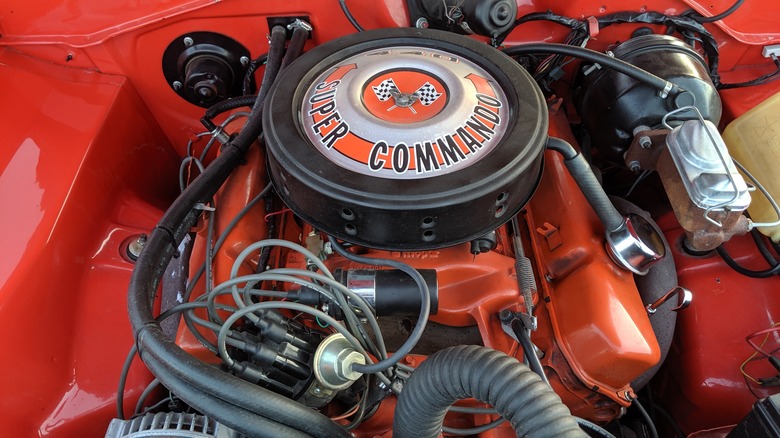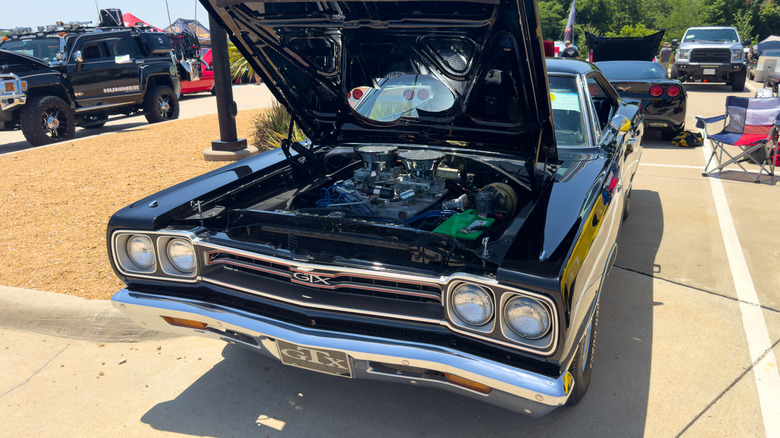
Tammy Karatchuk/Shutterstock
The Mopar family of vehicles encompasses everything from four-cylinder-powered Jeeps to some of the muscle car era’s most potent pavement eaters. Mopar is a portmanteau of the words «motor» and «parts,» but the word is also an umbrella term for the many brands that have come under the Chrysler umbrella since Walter Chrysler birthed his namesake company out of the Maxwell Motor Corporation 100 years ago.
Just four years later, Chrysler began to split his company into brands by intended market segment, establishing Plymouth at the low end of the market and DeSoto as a mid-level label. Although Chrysler sent DeSoto to the great salvage yard in the sky in 1960, and Plymouth suffered that same fate in 2001, The Mopar bucket still holds those brands along with Dodge, Jeep, Fiat, and Alfa Romeo.
After World War II, the United States market began to tilt towards high-performance muscle cars with large V8 engines, and Chrysler responded by producing beasts like the Plymouth Barracuda and Road Runner and the Dodge Charger. These cars were outfitted with big-block eight-cylinder motors, many of which had a displacement of more than 400 cubic inches, and cranked out upwards of 400 horsepower.
Only the biggest and strongest Mopar engine for the Viper
The biggest and strongest Mopar engine ever produced, though, was the 512.5 cubic inch (8.0 liter) V10 that was used in the Dodge Viper and some Dodge Trucks beginning in 1992. This engine was designed by Lamborghini, and produced 400 horsepower and 450 pound-feet of torque, according to Edmunds.
In his review of the 1992 Viper R/T10, Kevin Smith of Car and Driver was thrilled by the capabilities of the Viper’s massive powerplant. «Not even the most jaded long-time owner will ever reach for the Viper’s ignition switch without a palpable twinge of excitement,» he wrote. «Lighting off ten 799cc cylinders will always arouse the spirit.»
The Viper’s 10-cylinder engine was actually built off of the small-block «LA» series of Mopar V8 engines that had been in production since the 1950s. The Viper was discontinued in 2017 , but the V10 stayed in the Mopar family lineup, powering 2500 and 3500 series Ram pickups through 2003 and coming back a year later under the hood of the 2004-2006 SRT-10 pickup.
The first Mopar big block debuted in 1958
Some Jeep Wagoneers, Cherokees, and J-10 and J-20 pickups were outfitted with 390 and 401 cubic-inch V8s throughout the 1970s. However, many purists will point out that this came before Chrysler purchased the Jeep brand from AMC, and others will note that at 450 pounds, the 390 and 401 are not true big block engines. The first Chrysler B-series big block hit the streets during the 1958 model year in various sizes, ranging up to 383 cubic inches, and the following year the RB series 440 cubic-inch V8 was introduced.
These motors were a replacement for the first-generation hemi, which debuted in 1951. The 440 could be purchased with three two-barrel carburetors on some Dodge and Plymouth models. According to Driving Line, this fuel-thirsty setup boosted the 440’s output to 390 horsepower.
Changes in how horsepower was calculated dinged the 440’s numbers in the early ’70s, and troublesome electronic emissions systems hobbled the engine substantially later in the decade.
Big block hemis were racing legends
The B-series engines had a simpler head design than the outgoing hemis, and the RB or «raised block» series that followed became known as the «wedge» series due to the shape of its cylinders. Between 1962 and 1965, Dodge and Plymouth implemented 413 and 426 cubic inch versions of the RB V8 known as the Max Wedge. That engine lived from 1964 through 1971, and powered many Top Fuel dragsters, as well as the stock car of seven-time Cup series champion Richard Petty.
When the Max Wedge vanished in 1971, the 360 cubic-inch V8 appeared — hobbled by 1972 EPA regulations that inhibited airflow, and kept its output to 155 horsepower and 270 pound-feet of torque, according to Street Muscle Magazine. After the oil crisis hit soon after, Chrysler engineers set about maximizing the potential of all of the engines in the fleet, and by 1974, those numbers were up to 245 horsepower and 320 pound-feet.
[Featured image by ckirkman via Wikimedia Commons | Cropped and scaled | CC-BY 2.0]
The Gen II hemi was made in street and racing versions
At the tail end of the Max Wedge’s brief but impressive run, Plymouth and Dodge introduced the second-generation hemi. Instead of a cylinder-shaped combustion chamber, hemi engines have hemisphere-shaped chambers. The spark plug is placed at the top of the arch, allowing the piston to more easily cover the chamber, and providing room for larger intake and exhaust valves to be fitted.
Domed pistons are used to ensure adequate compression. The 426 cubic inch Hemi was initially built for racing only, but NASCAR homologation requirements forced Chrysler to put the Hemi into production, beginning in 1968.
The Top Fuel drag racing version of the 426 hemi could make up to an astonishing 11,000 horsepower burning nitro-methane fuel. According to Motor Trend, the street version of the Gen II Hemi had different camshaft and intake and exhaust manifolds from its racing cousin, along with lower compression ratio, but still produced 425 horsepower.
[Featured image by Stephen Foskett via Wikimedia Commons | Cropped and scaled | CC-BY 3.0]
The big block lasted until 1978

Khosrork/Getty Images
Dodge used the 426 hemi in Challenger, Coronet, Dart SS, and Super Bees between 1966 and 1971 and Plymouth dropped it under the hoods of a handful of cars in that same span, including the Barracuda, Belvedere, Fury GT, Road Runner, and GTX. A third generation hemi came along in 2003 with a displacement as large as 392 cubic inches, but the fact that it shares its block design with the LA series lands it in the grey area between big and small block engines.
The 440 cubic inch RB series motor, an undeniable big block at as much as 700 pounds with cast iron intake and exhaust manifolds, stayed in production until 1978. Smaller versions of the RB big block were also kept alive through that point, including the popular 383 and 400 cubic inch forms. By then, cast crankshafts had replaced the earlier forged versions, although Mopar’s big block engines remained carbureted long after many competitors had switched to fuel injection.